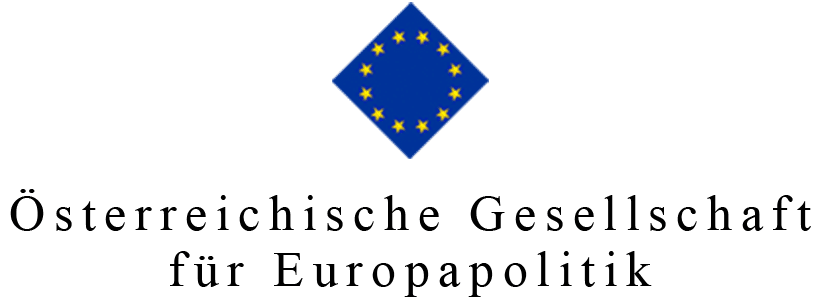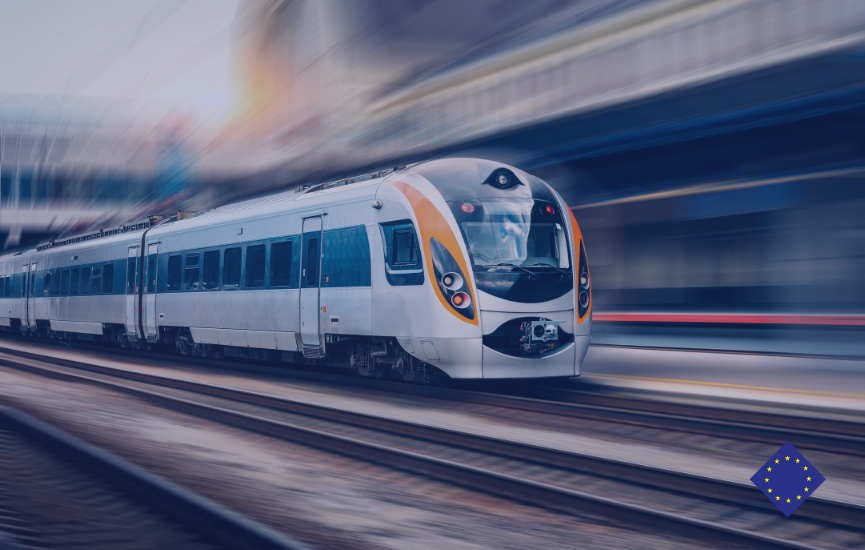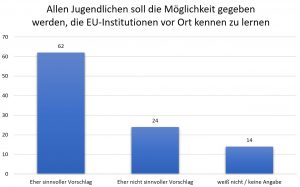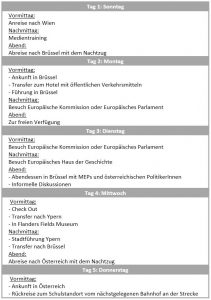Policy Recommendations
- Trips for young people to Brussels and the EU institutions need a sound educational approach.
- Such an ambitious project requires long-term and financial planning reliability for potential partners in order to have a sustainable impact.
- If successfully implemented, other EU countries might follow the Austrian example.
Abstract
The Austrian federal government has set itself the goal of enabling all 15 to 20-year-olds to travel to Brussels to visit the EU institutions once during their education. Particularly in view of the debate on the future of the European Union, it is important to sensitize young people to European politics and one way to do so is to implement this idea. After all, the opinion of young people must be heard when it comes to deciding on the future of European integration. There will come a time after the corona pandemic when all will be enabled to travel freely again and when the realization of this project can be kick-started in tangible terms. By then it should be clear how this project can actually be implemented.
The Wien-Aktion, which has been in existence for about 70 years, can serve as a model not only in terms of ideas, but also in terms of organization and financing. Building on the Wien-Aktion, existing funding programs and projects that have already successfully carried out comparable trips to Brussels, the implementation of this ambitious undertaking can gradually be achieved. Regarding the program the modular concept of the Wien-Aktion could be taken over and adapted. The focus of content should be on democratic and European political developments and contexts as well as the union´s ways of coping with Europe’s armed conflicts in history. With regard to climate change and the reopening of a direct night train connection between Austria and Brussels in 2020, this project should focus on rail travel. The duration of the school trip could be reduced to three days, and the direct costs for the students should not exceed €220 per person.
****************************
Making the European Capital Brussels tangible for the Next Generation
Introduction
In its coalition agreement, the Austrian Federal Government has set itself the goal of making the European Union (EU) tangible for Austrian young people:
“Ziel ist es, dass alle 15 – 20-Jährigen einmal in der Ausbildungszeit eine Woche nach Brüssel reisen und die EU-Institutionen kennenlernen.“[1]
The implementation of this objective would be an important step towards involving the next generation more closely in the development of the European Union and raise its interest in European democracy. An honest consideration of the views of young regarding the upcoming debate on the future of the European Union seems more urgent than ever.
[zitat inhalt=”With a trip to the ‘capital of the EU’, European integration should become a matter of the heart for young people, in addition to the necessary transfer of knowledge.”]
Promoting the European idea through travel and training is an idea that has been discovered as early as 1972[2], not only by the European railway companies´ Interrail program that is used by approximately 300,000[3] people a year. It is also supported directly by EU funding programs such as DiscoverEU, through which around 70,000[4] 18-year-olds have received a free Interrail pass since 2018, or Erasmus+ and its predecessors. The Austrian Federal Government has now included this idea in its current government program. With a trip to the “capital of the EU”, European integration should become a matter of the heart for young people, in addition to the necessary transfer of knowledge. This kind of educational trip also receives public support. A recent survey[5] by the Austrian Society for European Politics (ÖGfE), for example, shows that 62 percent[6] consider it useful to give all young people the opportunity to get to know the work of the EU institutions on the spot.
Figure 1
Surveys by telephone Tel SWS 290 Sozialwissenschaftliche Studiengesellschaft (SWS).
Survey period: 30.03. to 14.04. 2020
n= 512 representative for the Austrian population aged 16 and over
Maximum fluctuation margin: +/- 4.3 percent.
Above all political will is needed to implement this objective. The present policy brief aims to point out some of the pontential challenges, highlight existing funding programs, considering the European Parliament’s calendar and travel programs such as Europa.gemeinsam and the Wien-Aktion as examples, and to outline a possible model to make the project idea a reality.
Above all political will is needed to implement this objective.
Current situation
Challenges
The government’s aim of bringing all 15 to 20-year-olds closer to the European idea through a visit to Brussels is commendable. However, it would be useful to approach this project in stages.
First of all, it is important to take a closer look at the figures:
“Statistik Austria”[7] divides the population of Austria into age groups spanning five years. The age group of the 15 to 19-year-olds consists of 439,004 persons and the three younger age groups[8] range between 420,286 and 435,133 persons[9]
If one assumes that the number of young people is distributed more or less evenly among all age groups, one can expect that there would be about 85,000-86,000 young people traveling to Brussels in a given year.
Again, the number of accompanying teachers needed would also have to be considered. “[Bei] Schulveranstaltungen in der Dauer von bis zu einem Tag ab der 5. Schulstufe und bei mehrtägigen Schulveranstaltungen […] mit überwiegend projektbezogenen Inhalten [ist] je eine Begleitperson ab 17 bis 22 teilnehmenden Schülern und für je weitere 17 bis 22 teilnehmende Schüler[verpflichtend].[10]” Assuming a favorable ratio of 1:22, about 3,900 accompanying teachers would be needed to supervise such a number of students. [11]
It also has to be noted that a school year in Austria consists of only 40 weeks, during which the European Parliament usually meets eleven times in Strasbourg. Considering the European Parliament’s calendar this leaves a maximum of 29 weeks, in which such a journey could be made. This means that in each of these weeks approximately 3,100 people would set out to travel to “political” Brussels.
After it must be assumed that, due to the high number of trips, a meeting with Austrian Members of the Parliament (MEPs) would not be possible for all the students, weeks of plenary sessions in Strasbourg could of course be used to get to know the EU institutions in Brussels. If that is done, 39 weeks would be at disposal for traveling, even if there are no trips planned in the first week of the school year, what would be advisable. This measure would reduce the average weekly number of participants to 2,300 visitors, including the teachers.
By comparison, in 2019, 167 groups with a total of 4,752 persons visited the Austrian Permanent Representation in Brussels[12]. 2,300 persons correspond to 11.5 fully loaded Airbus A321, Austrian Airlines’ largest medium-range jet, of which six were operated by the airline before the COVID-19 pandemic[13]. Furthermore, this figure corresponds to six times the current passenger capacity of the direct night trains to Brussels for a Sunday to Monday night journey with a return journey from Thursday to Friday.
However, by making better use of the entire school year and reducing the trips to three days in Brussels the project becomes more realistic.
These figures and comparisons are in no way intended to be a deterrent, but are merely meant to illustrate the challenge that the Austrian Federal Government is facing with this target. However, by making better use of the entire school year and reducing the trips to three days in Brussels[14] the project becomes more realistic.
Present status of subsidies
Currently, six federal states offer subsidies for travels to the EU institutions in Brussels. However, the amount and criteria for subsidies vary. In Burgenland[15], Carinthia[16], Vorarlberg[17] and Styria[18], the funding is set to €100 per student. Salzburg[19], on the other hand, applies a variable system in which the amount of support depends on the evaluation of the respective concept. The target groups of these subsidies are schools or parents’ associations[20] in the respective federal state. In some cases the allowances are limited to students from the 9th[21] or 10th[22] grade. Tyrol[23] also offers funding for natural persons and legal entities; EU information events taking place in Tyrol receive financial support from the same program; the amount of funding is not explicitly stated by the Tyrolian regional government and depends on the project submitted.
Most funding bodies require a pedagogical concept and the visit of an EU institution. Accordingly, some federal states[24] not only support trips to Brussels, but also to Strasbourg or Luxembourg. Furthermore, all funding recipients are required to document the trips and to make these documentations available to the responsible funding agencies for publication. Carinthia requires the travelers to visit the liaison office of the province of Carinthia in Brussels. In Styria a compulsory preparatory two-hour workshop is to be held by the Europe Direct Information Centre[25] Styria.
The picture that emerges from the current structure and conditions of subsidies already points out some implementation possibilities. These consist of:
1) The preparatory work, also with the help of external partners.
2) The visit of specific institutions.
3) The follow-up or obligatory documentation with publication possibilities.
4) The funding of the federal states (€100 per participant).
The following examples of implementation and organization are intended to show that such a demanding vision can become a reality with appropriate adaptations and that it is possible to approach this goal step by step.
Best practice examples in comparison
The Wien-Aktion
„Das Bundesministerium für Bildung, Wissenschaft und Forschung (BMBWF) organisiert die Aktion ‚Österreichs Jugend lernt ihre Bundeshauptstadt kennen‘ (Wien-Aktion) bereits seit etwa 70 Jahren und führt viele tausende Schüler/innen jedes Jahr nach Wien. Der einwöchige Aufenthalt soll der österreichischen Jugend die historisch-politische, kulturelle und wirtschaftliche Bedeutung Wiens in Vergangenheit, Gegenwart und Zukunft verständlich machen.“[26]
The Wien-Aktion[27] was founded about 70 years ago, i.e. immediately after the Second World War, with the aim of establishing the young Second Austrian Republic as an independent state in contrast to the Third Reich, with Vienna as its capital, in the minds of students from the federal states[28]. Its target group “sind Schüler/innen der 7. bis 13. Schulstufe“.[29] Vocational schools are not included in the “Wien-Aktion”. During the last three years, an average of 21,445 students per year[30] have taken part. However, it should be noted that approxmately 39%[31] of Austrian students attend school in the federal states of Vienna and Lower Austria and, due to their neighborhood to the federal capital, hardly or not at all make use of this offer. Nevertheless, the Wien-Aktion can serve as a model for school trips to Brussels.
Europa.gemeinsam
Europa.gemeinsam[34] is a project carried out by several partners with the aim of bringing the European Union and the idea of a peaceful Europe closer to Austrian apprentices through a trip to Brussels and Ypres. The project is mainly financed by the “Zukunftsfonds der Republik Österreich”[35].[36]
The “Verband Österreichischer Volkshochschulen”[37] has developed the visits underlying concept that supports the engagement with the European Union and discusses its role in conflict prevention and peacebuilding. The apprentices are asked to actively participate. The students produce video clips which are included in the documentation aired by Okto TV[38]. The media-pedagogical support, the production and broadcasting of the film documentary has so far been carried out by the Tolikas Media Company[39] and Okto TV.
However, the written survey of the apprentices carried out before and after the trip showed that the attitude towards the European idea as well as the knowledge about the European Union has changed, respectively improved.
In the course of the project, three trips to Brussels were carried out[40], a fourth is in the planning phase and will be implemented at a later date due to the current situation around the COVID-19 pandemic.
When preparing for the respective trips participating classes attended a workshop from the Europa #wasistjetzt series of the ÖGfE.
The trips lasted for three days each and took place from Sunday morning to Tuesday evening. On the first day, the apprentices arrived in Brussels via plane. They participated in a guided tour in Brussels and a media workshop. The second day was devoted to the visit of the European Commission, the European Parliament, the Permanent Representation of Austria to the EU and an evening reception with politicians, journalists and Austrians, who live and work in Brussels. On the third day, the memorial to the battles of the First World War in Ypres was visited, and in the evening they left Brussels to travel back to Austria.
The trip´s program, a combination of current European politics and historical aspects, was evaluated positively by the participants and the same was the case regarding the opportunity for direct and informal exchange with politicians and experts. The very dense program and the associated lack of free time for independent exploration of the city was rated negatively. However, the written survey of the apprentices carried out before and after the trip showed that the attitude towards the European idea as well as the knowledge about the European Union has changed, respectively improved. This clearly shows that educational trips such as this one can achieve their democratic goals.
In accordance with the previous experience of Europa.gemeinsam[41], the program has been extended by one day for the fourth round and, with climate change in mind, a journey by ÖBB[42] Nightjet[43] has been planned, after the ÖBB has reopened its direct connection to Brussels in January 2020. The planned schedule is shown in the following table:
Brussels Days: How to make it happen
If the government’s plan is viewed in conjunction with the current funding programs of the federal states and the experiences gained from the Wien-Aktion and Europa.gemeinsam, the following ideas for the implementation and structure of a series of “Brussels trips” can be derived.
In order to provide the students with a content-related basis for the trip, preparatory workshops, such as those offered by EDI Styria or ÖGfE, among others, are a good start. These workshops would be particularly recommended in the first years of the project, as the accompanying teachers would also benefit from them. Even at a later stage, workshops by external experts will still be a good supplement to the regular lessons in the classroom. However, the schoolteachers themselves could then also carry out the preparation for the trip to Brussels since they will have acquired the necessary know-how in the course of the years.
In contrast to the Wien-Aktion, the trips to Brussels should focus exclusively on political and historical content and could thus be shortened to three days on site. This measure would increase the potential travel dates significantly.
The journey to and from Brussels could be done via the ÖBB Nightjet.
The journey to and from Brussels could be done via the ÖBB Nightjet. If the Nightjet connection to Brussels is expanded to a daily connection, the currently planned capacity from 2022 onwards will be able to transport about 10,000 students per school year on this route. From a technical point of view, it would even be possible with a lead time of another two years to further increase the capacity in order to allow about 90,000 youth per school year to travel by night train in a climate-friendly way. This would, however, require a corresponding safeguarding of the program on the part of the federal government, as investments would have to be made in the rolling stock to accommodate this number of people. A gradual increase in capacity beginning in 2022 from 10,000 passengers up to 90,000 in full expansion is possible and would also bring advantages in terms of planning and economies of scale.[44] To reduce costs to the approximate level of the Wien-Aktion, similarly high numbers of participants (approximately 21,000 per year) would be required. With lower numbers of participants correspondingly higher prices would have to be expected.[45]
The curriculum could be based on that of the ‘Europa.gemeinsam’ trips and at the same time adopt the modularity of the ‘Wien-Aktion’, with a clear focus on communicating political content.
The curriculum could be based on that of the Europa.gemeinsam trips and at the same time adopt the modularity of the Wien-Aktion, with a clear focus on communicating political content. Possible European policy content could include a visit to the European Commission, the Council of the European Union, the European Committee of the Regions, the European Economic and Social Committee, the Permanent Representation of Austria to the EU, the representation of the federal state[46] of the respective school or the House of European History. Examples of possible historical content are offered in the form of a visit to the Flanders Fields Museum in Ypres, the Battlefield of Waterloo, the Africa Museum or the Jewish Deportation and Resistance Museum. In addition, a guided city tour could be offered for orientation and “arriving” in Brussels.
The ratio of political to historical[47] content from the program should be four to two[48]. As with the Wien-Aktion, schools could of course book supplementary points in addition to the basic program offered, and the trip could be extended if desired. Such an extension of the program would of course have to be carried out beyond the schedule and paid separately.
The costs arising for the students should be similar to the Wien-Aktion. As already discussed, these currently amount to €165 for a 5-day week without travel costs. Accordingly, the costs for a 3–day trip to Brussels, including travel costs, should not exceed €220. The contribution could be further reduced by a subsidy from school`s respective federal state, similar to the current subsidy situation in Carinthia. This would mean that, in addition to the travel expenses to and from Brussels by night train in a 6-seater couchette with currently around €120, the costs of accommodation, board, public transport tickets and admissions to museums would be set at the same level as for the Wien-Aktion[49]. Possible higher costs at the beginning of the program until the above-mentioned economies of scale are fully achieved could be covered by the federal budget in order to be able to offer all students affordable travel[50]. As with the Wien-Aktion and the “Europa-Aktion”[51], the central organization should be located in the Austrian Federal Ministry of Education, Science and Research, as this is where the relevant expertise is to be found.
The costs arising for the students should be similar to the ‘Wien-Aktion’.
Conclusions
Where there is political will, there is a way. In its current coalition agreement, the Austrian Federal Government has formulated the objective to enable all young people aged 15 to 19 to travel to Brussels as part of their secondary education. In contrast to the Wien-Aktion this also includes vocational school students. The implementation of this project would be a further step towards raising awareness and involving young people, as their views must be taken into account in the upcoming debate on the future of the European Union.
In order to give as many young people as possible the chance to get to know the “capital of the EU”, a medium-term strategy and public funding possibilities are needed, especially for the initial phase of the project. On the one hand, incentives are needed for schools and teachers to make this journey happen, on the other hand the young people and their families need to be financially supported.
The central organization should be located at the Austrian Federal Ministry of Education, Science and Research, in order to make use of the ministry’s expertise with organizing school trips.
Furthermore, the Brussels trips must be based on a sound educational concept that communicate the values of a modern, pluralistic European democracy, refers to the historical successes of European unification and makes it clear that these are by no means a matter of course. In developing the concept, organizations that have already worked in this field over a longer period and that have the relevant experience and expertise, such as ÖGfE or Europa.gemeinsam, should be involved. The preparation and wrap-up of the trips must be planned thoroughly. The central organization should be located at the Austrian Federal Ministry of Education, Science and Research, in order to make use of the ministry’s expertise with organizing school trips.
Due to the large number of potential participants, this project could be implemented with relatively little financial effort on the part of the federal government and low-cost contributions from the participants.
A project of this scale needs long term planning, because the value of (European) democracy, a sense of Europe’s diversity and its cohesion must be passed on from generation to generation. The fact that the Wien-Aktion, which is similar in certain respects, has already existed successfully for seven decades also implicates that financial planning security is essential for potential partners. This is particularly true for further investment in the direct train connection to Brussels, which is necessary for a climate friendly implementation.
Due to the large number of potential participants, this project could be implemented with relatively little financial effort on the part of the federal government and low-cost contributions from the participants.[52] Only in the start-up phase subsidies would be needed.
This educational project could be presented as best practice within the EU, with the aim of motivating other EU member states to implement similar activities.
Now is the time to advance with the concrete planning of this idea. After all, the opportunity to travel freely will hopefully return soon.
[1] ”The aim is for all 15 – 20 year olds to travel to Brussels for a week once during the education to get to know the EU institutions.” „Aus Verantwortung für Österreich. Regierungsprogramm 2020-2024“, Die Neue Volkspartei/Die Grünen – Die Grüne Alternative, Seite 178, https://www.wienerzeitung.at/nachrichten/politik/oesterreich/2044635-Das-Regierungsprogramm-zum-Downloaden.html (16.03.2020).
[2] https://www.railaxed.at/reisetipps/abenteuer-europa/retrofeeling-interrail.html (26.3.2020).
[3] https://www.europarl.europa.eu/news/de/headlines/economy/20161007STO46205/interrail-zahlen-und-fakten https://www.europarl.europa.eu/news/de/headlines/economy/20161007STO46205/interrail-zahlen-und-fakten(26.03.2020)
[4] https://europa.eu/youth/discovereu_de (26.03.2020).
[5] SWS surveys by telephone on behalf of ÖGfE from 30.03. to 14.04.2020 with 512 representatively selected Austrians.
[6] 24 percent no sensible suggestion / 14 percent do not know / no comment.
[7] Statistics Austria, Austrian Federal Statistical Office
[8] 0-4 years, 5-9 years and 10 to 14 years.
[9] Population at beginning of 2002-2019 by five-year age groups and sex, https://www.statistik.at/wcm/idc/idcplg?IdcService=GET_PDF_FILE&RevisionSelectionMethod=LatestReleased&dDocName=023468 (26.03.2020).
[10] “[For] school events lasting up to one day from the 5th grade onwards and school events lasting several days […] with predominantly project-related content one accompanying teacher [is obligatory] for each 17 to 22 participating pupils and for each additional 17 to 22 participating pupils.” Verordnung des Bundesministers für Unterricht und kulturelle Angelegenheiten über Schulveranstaltungen (Directive of the Federal Minister for Education and Cultural Affairs on school events) (Schulveranstaltungenverordnung 1995 – SchVV) §2. (4) 2.b), https://www.ris.bka.gv.at/GeltendeFassung.wxe?Abfrage=Bundesnormen&Gesetzesnummer=10009986 (26.03.2020).
[11]Apart from the legal requirements, the group size, according to our experience, should be around 50 participants.
[12] https://www.bmeia.gv.at/oev-bruessel/besucherdienst/ (26.03.2020).
[13] https://www.austrian.com/Info/Flightinformation/OurFleet.aspx?sc_lang=de&cc=AT (26.03.2020)
[14] By staggering arrival and departure, it should not only be possible to reduce the maximum number of beds required but also spread the load for the train rides needed. Three arrival and departure days per week would be possible (Monday to Wednesday, Tuesday to Thursday and Wednesday to Friday).
[15] https://www.rmb.at/eu-schulreisen/ (18.03.2020); https://www.ljr.at/foerderungen/foerderungen-des-ljr/eu-schulklassen-foerderung/ (18.03.2020).
[16] https://transparenzportal.gv.at/tdb/tp/leistung/1016591.html (18.03.2020). https://europa.ktn.gv.at/aktionen/Br%c3%bcssel-Schulaktion (18.03.2020).
[17] Information by e-mail from EDIC Vorarlberg on June 25 2020 after publication of the German version of the ÖGfE Policy Brief. Receipt of the publicly available source on 26 June 2020. https://vorarlberg.at/documents/21336/396307/Infoblatt/12abd181-efa1-435d-ad3e-61ee299fe762 (26.06.2020).
[18] https://www.europa.steiermark.at/cms/beitrag/11604508/2950520/ (18.03.2020).
[19] https://transparenzportal.gv.at/tdb/tp/leistung/1018282.html (18.03.2020) https://www.salzburg.gv.at/europa_/Seiten/schul-eu-projekte.aspx (18.03.2020).
[23] https://transparenzportal.gv.at/tdb/tp/leistung/1018779.html (18.03.2020) https://www.tirol.gv.at/fileadmin/themen/tirol-europa/europainformation/downloads/Foerderrichtlinien_neu.pdf (18.05.2020).
[24] Burgenland, Salzburg, Styria, Tyrol and Vorarlberg
[25] https://europainfo.at/edis/ (19.03.2020)
[26] The Federal Ministry of Education, Science and Research (BMBWF) has been organising the campaign ‘Austria’s youth gets to know its capital city’ (Wien-Aktion) for about 70 years and brings many thousands of students to Vienna every year. The one-week stay is intended to make Austrian youth understand the historical-political, cultural and economic significance of Vienna in the past, present and future. https://www.bmbwf.gv.at/Themen/schule/schulpraxis/pwi/wien/wienaktion.html (30.03.2020).
[27] Information on the Wien-Aktion that goes beyond the publicly accessible sources mentioned above was kindly provided to Mr. Kurri by the responsible department I/8a of the BMBWF via e-mail.
[28] The federal states have a perceived mistrust in the capital, a city with over a million inhabitants with a unique character – hence, it is often seen as “a head too big for its body”. Which is of course a reason why the analogy “Austrian federal states vs. Vienna” and “EU member states vs. Brussels” seem to fall into place perfectly.
[29] “are pupils of the 7th to 13th grade”, https://www.bmbwf.gv.at/dam/jcr:dad28bee-2ef5-46ec-a296-554aa3b19ab0/wienaktion_leitfaden.pdf, page 8, (30.03.2020).
[30] 2016/17: 21.841, 2017/18: 21.189 and 2018/19 21.306.
[31] https://www.statistik.at/wcm/idc/idcplg?IdcService=GET_PDF_FILE&RevisionSelectionMethod=LatestReleased&dDocName=055448 (30.04.2020).
[32] Vienna’s public transport network
[33] https://www.bmbwf.gv.at/dam/jcr:dad28bee-2ef5-46ec-a296-554aa3b19ab0/wienaktion_leitfaden.pdf (30.03.2020).
[34] Europe.together is a joint project of the “Verband Österreichischer Volkshochschulen”, the ÖGfE and the Diplomatic Academy of Vienna. https://europagemeinsam.at/ (23.03.2020).
[35] Future Fund of the Republic of Austria
[36] http://www.zukunftsfonds-austria.at/projects.php?aktion=suchen&suchbegriff=europa.gemeinsam#projectlist (06.04.2020).
[37] Association of Austrian Adult Education Centres in Austria
[38] https://oktothek.tv/de/sendung/europagemeinsam (06.04.2020).
[39] https://www.tolikas-media-company.com/ (06.04.2020).
[40] 173 apprentices, their accompanying teachers from eight federal states and representatives of all participating organizations took part in the three trips.
[41] The authors have received the evaluations and plans, but no publication is planned currently. A publicly accessible article on the first trip is available at http://magazin.vhs.or.at/magazin/2017-2/263-winter-201718/bildungsthemen/europa-gemeinsam/ (01.04.2020).
[42] Austrian Federal Railways
[43] Night train product of ÖBB
[44] Information on planning and capacities of the night jet originate from discussions and e-mail traffic with ÖBB.
[45] If the system is fully rolled out for all students in the relevant age groups, it is even conceivable that the individual costs for the students would fall further.
[46] With the exception of Vorarlberg, all federal states have such a representation.
[47] Historical means, in the context of the Brussels trip, is above all the bellicose history of the European continent as well as a critical view on European colonial history from a Belgian perspective.
[48] Cultural programs, such as visits to the theatre, would, on the one hand, increase costs due to the additional time required and the costs of the tickets, on the other hand, there would also be the problem of the existing language barrier.
[49] In a 3-day version without a visit to the theatre.
[50] Publicly available prices from commercial providers would currently suggest costs of around €350-400 per person for a comparable trip and therefore require a subsidy of €130-180 per person to achieve the target cost of €220 for the participants.
[51] A service for foreign schools that want to visit Vienna.
[52] If the organization were to be left to the schools, one would have to expect prices to be more than twice as high. In order to be able to compensate for these additional costs for the students, the federal government would have to contribute more than €20 million annually in the full implementation phase.
ISSN 2305-2635
The views expressed in this publication are those of the authors and not necessarily those of the Austrian Society of European Politics or the organisation for which the authors are working.
Keywords
political education, European education, night train, Brussels, European youth, future of Europe, program of the government
Citation
Kurri, P., Schmidt, P. (2020). Making the European Capital Brussels tangible for the Next Generation. Vienna. ÖGfE Policy Brief, 16a’2020










